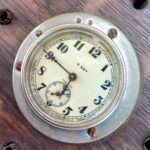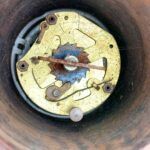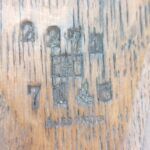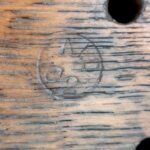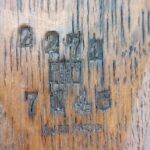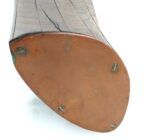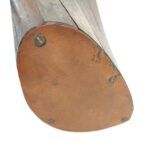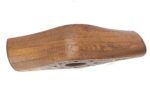*Canada, WW1, Curtiss JN4C (Canuck) Propeller Sessions Clock*
This WW1 era propeller has been made into a clock. It features an 8 Day clock manufactured by The Sessions Clock Co., Forrestville, Conn. U.S.A with rear winding fitted to central wooden propeller boss. The propeller may be from the Canadian Curtiss Canuck JN4C, c917. Used by both the US Army Air Service and the Canadian Royal Flying Corps. Both ends of the boss fitted with copper panels. Rear of boss with issue stamps (detailed below).
The Curtiss JN-4, often regarded as North America’s most famous World War I aircraft, was widely used for pilot training during the war, with around 95% of all trainees flying a JN-4. Curtiss received orders from both the US Army and the Royal Flying Corps (RFC) in Canada, with Canadian Aeroplanes Ltd established in late 1916 primarily to produce JN-4 trainers for the Canadian RFC. Following the US entry into WWI in 1917, many of these Canadian-made “Jennys” were shipped to the USA. A total of 1,260 units were built by Canadian Aeroplanes Ltd for the RFC/RAF in Canada and the US Army Air Service.
Lang Propellers of America also subcontracted propeller production to Canadian Aeroplanes Ltd. Dashwood Lang, a British propeller manufacturer whose company served as the in-house supplier for Sopwith aircraft, was loaned to the US Navy by the British Admiralty in 1917 when America entered World War I. His role was to help establish mass production of propellers, and he enlisted manufacturers from Canada to assist in this effort. (Bob Gardner, Author; WW1 British Propellers)
While primarily a trainer, the Jenny was frequently modified for additional roles. The Canadian version, known as the JN-4 (Canadian) or “Canuck,” featured distinctions from the American model, such as a lighter airframe, ailerons on both wings, a larger, more rounded rudder, and differently shaped wings, stabilizer, and elevators. However, deployment of these aircraft was confined to North American bases, and none saw combat in World War I.
The Sessions Clock Company (“Sessions”) was founded in 1902 and was one of several notable American clock companies centered in Connecticut. At about 1935, Sessions ended its production of mechanical clocks and produced electrical clocks exclusively.
Approximate measurements:
Propeller piece with copper ends – 42cm x 19.5cm x 10.5cm deep
Clock – 9cm diameter (inc frame)
Bolt circle – 5,2″ diameter
Hub (metal) – 6″ diameter
8 bolt holes
Markings:
“2272”, Box (indistinct) “CA Ltd 47”, “7145” over an Indistinct stamp that may be “A.J. Edmonds”. CA Ltd – stands for Canadian Aeroplanes Limited. A.J. Edmonds is likely to have been an inspector for Canadian Aeroplanes Limited at the time and his stamp has been found on other Canuck propellers.
“AID C2” in a circle on both sides of the hub – the AID stamps represent Aeronautical Inspectorate Division and C2 has been found on other Jenny propellers.
8′-3’X 5.00 Right Hand
*Condition*
Good used condition. The clock has not been tested, the face is slightly rippled. This is a unique piece of history with the extremely collectible Sessions clock and Canuck propeller piece. Please see photographs as part of the condition report.
RQMBEOXDEO_9776175929















